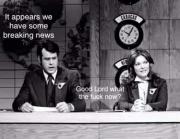I absolutely get where Kevin is coming from, too, but like you, George, my brain often goes all mathy about this stuff. It's a great example of missing the forest for the trees, probably, but in this case we're specifically talking about a tree. Does that make sense?
Now let's talk specifically about this statement: "Todd's prioritization of accuracy over speed in a training environment"
There are a lot of folks -- including quite a few folks I admire -- who would say the exact opposite about me and my classes. One well known instructor has made some very public disparaging comments about what he calls "Aim Fast Miss Fast."
Compared to him, then, I'm prioritizing speed over accuracy. Compared to you, perhaps I'm prioritizing accuracy over speed.
Anyone can get faster if they accept poorer accuracy. My goal is to get faster without sacrificing accuracy. Because -- and I think this gets back to Kevin's point and he can correct me if I'm wrong -- at the end of the day what matters is what my practice has enabled me to do when I really need to do it. When (if) that time comes, misses cost me ammo and time. Since general experience informs us that most folks get less accurate (but not slower) in those cases, I don't want to see if 95% becomes 80%. I certainly don't want to see if 80% becomes 50%.
Going back to the math, think about what you're proposing in terms of the Rogers test. Would you rather go in knowing that you'll score 100 (80%) points plus some makeup shots (if you have time) or go in confident you'll score 119 (95%) points up front? At Rogers, as you well know, a makeup hit is better than a miss but it's certainly substantially worse than a hit on your first try.
Again, that's just me. It's how my personal view is molded by my priorities and beliefs. I'd never criticize the guy who wants students to make all hits on a 5" circle as long as everyone understands how that affects training and skill-building overall (both positive and negative). Nor do I criticize someone who decides 80% hits on target-xyz is appropriate or acceptable, with the same caveat.
But if you can't get a hit on a low% target first time every time when you absolutely need to, under stress, under time pressure, then personally I think that's a serious deficiency. And in my opinion, it's easier to back off from 95% to 100% on demand than it is to back off from 80% to 100% on demand. The F.A.S.T. is a great example, because I've seen a lot of incredible shooters who can't seem to hit that 3x5 consistently on demand under the simple stress of winning some random blogger's challenge coin.




 Reply With Quote
Reply With Quote



